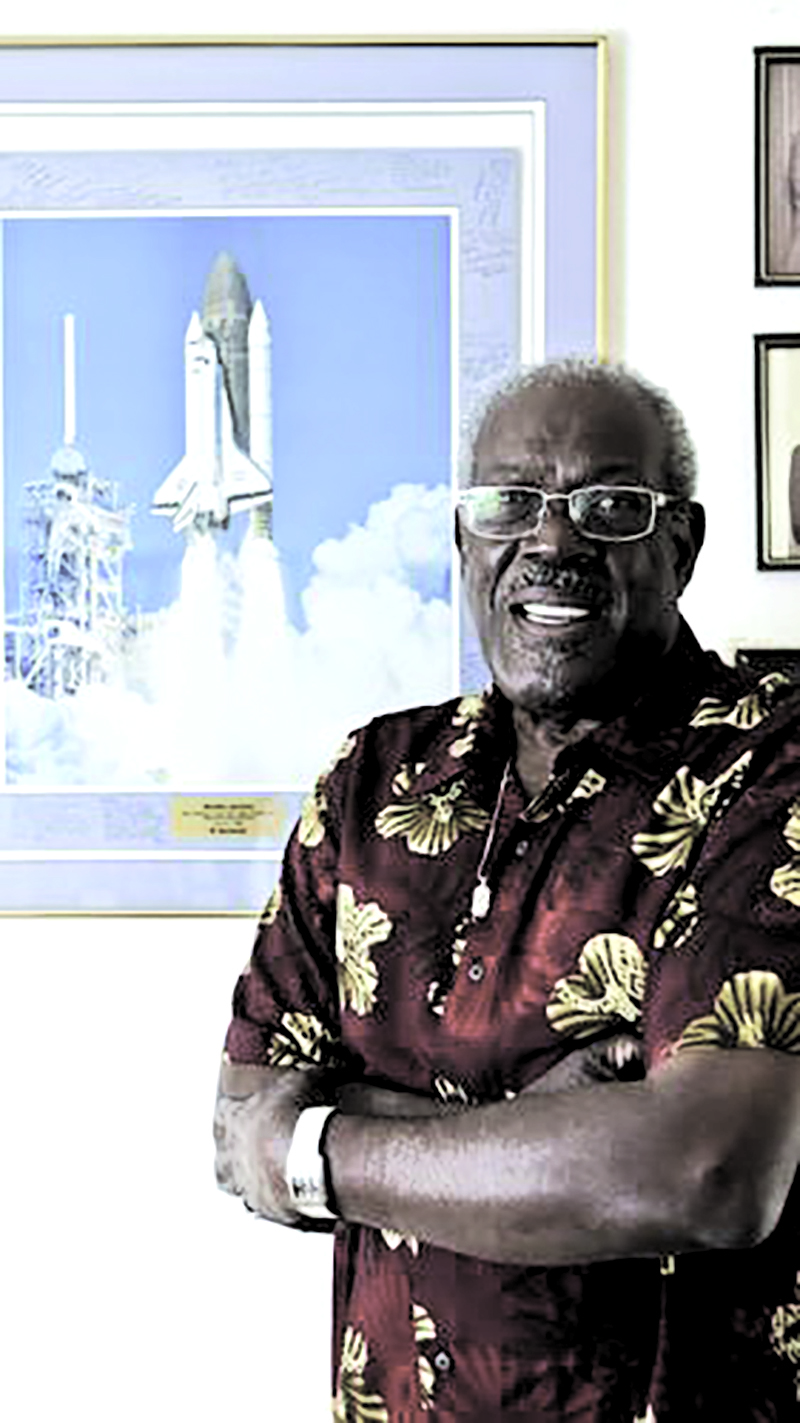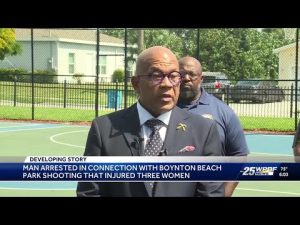Uncategorized
After 51 Years, Shelby Jacobs’ Pioneering Work as a NASA Camera Designer is Finally Being Recognized

When the unmanned Apollo 6 rocket launched in the spring of 1968, it carried with it a camera that took images in space that had never previously been captured – thanks to the vision and work of Black NASA engineer, Shelby Jacobs.
A native of Santa Clarita Valley, Ca, Jacobs early experiences as a part of the 1 percent Black student population of his high school class soon prepared him to excel in the face of overt prejudice and low expectations. He became a standout athlete, student body president, and ultimately earned a scholarship to UCLA. While he intended to study mechanical engineering, his high school principal warned him that because of his race he may face some difficulties in the field.
“I didn’t translate his comments negatively,” Jacobs told the L.A. Times. “He was letting me know the playing field was not level, and I appreciated his honesty.”
He enrolled in UCLA in 1953 and immediately began to immerse himself in his studies. After three years on campus, he was then hired into a space program that built rockets used in Mercury, Atlas, Jupiter, and Thor programs. At that time, there were 5,000 engineers in this program and only eight of them were Black. While attempting to assimilate as best he could among his white counterparts, Jacobs endured never-ending racial comments, overt discrimination, and often had to challenge their misinformed assumptions about Black people. He was also paid significantly less than those who were performing the same work that he was.
In 1961, President John F. Kennedy announced the Apollo Space Program and Jacobs transferred to Rockwell in Downey, Ca. It was here that he worked for three years testing and perfecting the new camera system that ultimately accompanied the Apollo 6 rocket into space to capture some of the first documented images taken in space. While the assassination of Dr. Martin Luther King, Jr. cast a dark cloud over the year 1968, after the successful space launch Jacobs continued to thrive in the space program and garner various promotions. He ultimately retired in 1996.
In 2009, Jacobs was named an “unsung hero” by NASA. He and his wife were also inspired in 2016 after the release of “Hidden Figures” to advocate for equal compensation for persons of color and women engineers – as well as also encourage museums not to leave out the contributions of Black people to advancements in the aerospace industry.
The Columbia Memorial Space Center in Downey now features an exhibit entitled, “Achieving the Impossible: The Life and Dreams of Shelby Jacobs” that will run through the spring. In honor of Black History Month, the museum will also have a daylong program on February 16.
This story comes from the “Because of Them We Can” web site.
Uncategorized
Oakland Housing and Community Development Department Awards $80.5 Million to Affordable Housing Developments
Special to The Post
The City of Oakland’s Housing and Community Development Department (Oakland HCD) announced its awardees for the 2024-2025 New Construction of Multifamily Affordable Housing Notice of Funding Availability (New Construction NOFA) today Five permanently affordable housing developments received awards out of 24 applications received by the Department, with award amounts ranging from $7 million to $28 million.
In a statement released on Jan. 16, Oakland’s HCD stated, “Five New Construction Multifamily Affordable Housing Development projects awarded a total of $80.5 million to develop 583 affordable rental homes throughout Oakland. Awardees will leverage the City’s investments to apply for funding from the state and private entities.”
In December, the office of Rebecca Kaplan, interim District 2 City Councilmember, worked with HCD to allocate an additional $10 Million from Measure U to the funding pool. The legislation also readopted various capital improvement projects including street paving and upgrades to public facilities.
The following Oakland affordable housing developments have been awarded in the current round:
Mandela Station Affordable
- 238 Affordable Units including 60 dedicated for Homeless/Special Needs
- Award: $15 million + previously awarded $18 million
- Developer: Mandela Station LP (Pacific West Communities, Inc. and Strategic Urban Development Alliance, LLC)
- City Council District: 3
- Address: 1451 7th St.
Liberation Park Residences
- 118 Affordable Units including 30 dedicated for Homeless/Special Needs
- Award: $28 million
- Developer: Eden Housing and Black Cultural Zone
- City Council District: 6
- Address: 7101 Foothill Blvd.
34th & San Pablo
- 59 Affordable Units including 30 dedicated for Homeless/Special Needs
- Award: $7 million
- Developer: 34SP Development LP (EBALDC)
- City Council District: 3
- Address: 3419-3431 San Pablo Ave.
The Eliza
- 96 Affordable Units including 20 dedicated for Homeless/Special Needs
- Award: $20 million
- Developer: Mercy Housing California
- City Council District: 3
- Address: 2125 Telegraph Ave.
3135 San Pablo
- 72 Affordable Units including 36 dedicated for Homeless/Special Needs
- Award: $10.5 million
- Developer: SAHA and St. Mary’s Center
- City Council District: 3
- Address: 3515 San Pablo Ave.
The source of this story is the media reltations office of District 2 City Councilmember Rebecca Kaplan.
Activism
Oakland Housing and Community Development Department Awards $80.5 Million to Affordable Housing Developments
In a statement released on Jan. 16, Oakland’s HCD stated, “Five New Construction Multifamily Affordable Housing Development projects awarded a total of $80.5 million to develop 583 affordable rental homes throughout Oakland. Awardees will leverage the City’s investments to apply for funding from the state and private entities.”

Special to The Post
The City of Oakland’s Housing and Community Development Department (Oakland HCD) announced its awardees for the 2024-2025 New Construction of Multifamily Affordable Housing Notice of Funding Availability (New Construction NOFA) today Five permanently affordable housing developments received awards out of 24 applications received by the Department, with award amounts ranging from $7 million to $28 million.
In a statement released on Jan. 16, Oakland’s HCD stated, “Five New Construction Multifamily Affordable Housing Development projects awarded a total of $80.5 million to develop 583 affordable rental homes throughout Oakland. Awardees will leverage the City’s investments to apply for funding from the state and private entities.”
In December, the office of Rebecca Kaplan, interim District 2 City Councilmember, worked with HCD to allocate an additional $10 Million from Measure U to the funding pool. The legislation also readopted various capital improvement projects including street paving and upgrades to public facilities.
The following Oakland affordable housing developments have been awarded in the current round:
Mandela Station Affordable
- 238 Affordable Units including 60 dedicated for Homeless/Special Needs
- Award: $15 million + previously awarded $18 million
- Developer: Mandela Station LP (Pacific West Communities, Inc. and Strategic Urban Development Alliance, LLC)
- City Council District: 3
- Address: 1451 7th St.
Liberation Park Residences
- 118 Affordable Units including 30 dedicated for Homeless/Special Needs
- Award: $28 million
- Developer: Eden Housing and Black Cultural Zone
- City Council District: 6
- Address: 7101 Foothill Blvd.
34th & San Pablo
- 59 Affordable Units including 30 dedicated for Homeless/Special Needs
- Award: $7 million
- Developer: 34SP Development LP (EBALDC)
- City Council District: 3
- Address: 3419-3431 San Pablo Ave.
The Eliza
- 96 Affordable Units, including 20 dedicated for Homeless/Special Needs
- Award: $20 million
- Developer: Mercy Housing California
- City Council District: 3
- Address: 2125 Telegraph Ave.
3135 San Pablo
- 72 Affordable Units including 36 dedicated for Homeless/Special Needs
- Award: $10.5 million
- Developer: SAHA and St. Mary’s Center
- City Council District: 3
- Address: 3515 San Pablo Ave.
The source of this story is media reltations office of District 2 City Councilmember Rebecca Kaplan.
Alameda County
Oakland Acquisition Company’s Acquisition of County’s Interest in Coliseum Property on the Verge of Completion
The Board of Supervisors is committed to closing the deal expeditiously, and County staff have worked tirelessly to move the deal forward on mutually agreeable terms. The parties are down to the final details and, with the cooperation of OAC and Coliseum Way Partners, LLC, the Board will take a public vote at an upcoming meeting to seal this transaction.

Special to The Post
The County of Alameda announced this week that a deal allowing the Oakland Acquisition Company, LLC, (“OAC”) to acquire the County’s 50% undivided interest in the Oakland- Alameda County Coliseum complex is in the final stages of completion.
The Board of Supervisors is committed to closing the deal expeditiously, and County staff have worked tirelessly to move the deal forward on mutually agreeable terms. The parties are down to the final details and, with the cooperation of OAC and Coliseum Way Partners, LLC, the Board will take a public vote at an upcoming meeting to seal this transaction.
Oakland has already finalized a purchase and sale agreement with OAC for its interest in the property. OAC’s acquisition of the County’s property interest will achieve two longstanding goals of the County:
- The Oakland-Alameda Coliseum complex will finally be under the control of a sole owner with capacity to make unilateral decisions regarding the property; and
- The County will be out of the sports and entertainment business, free to focus and rededicate resources to its core safety net
In an October 2024 press release from the City of Oakland, the former Oakland mayor described the sale of its 50% interest in the property as an “historic achievement” stating that the transaction will “continue to pay dividends for generations to come.”
The Board of Supervisors is pleased to facilitate single-entity ownership of this property uniquely centered in a corridor of East Oakland that has amazing potential.
“The County is committed to bringing its negotiations with OAC to a close,” said Board President David Haubert.
-

 Activism3 weeks ago
Activism3 weeks agoOakland Post: Week of November 12 – 18, 2025
-

 Activism3 weeks ago
Activism3 weeks agoIN MEMORIAM: William ‘Bill’ Patterson, 94
-

 Activism3 weeks ago
Activism3 weeks agoHow Charles R. Drew University Navigated More Than $20 Million in Fed Cuts – Still Prioritizing Students and Community Health
-

 Bay Area3 weeks ago
Bay Area3 weeks agoNo Justice in the Justice System
-

 #NNPA BlackPress3 weeks ago
#NNPA BlackPress3 weeks agoThe Perfumed Hand of Hypocrisy: Trump Hosted Former Terror Suspect While America Condemns a Muslim Mayor
-

 #NNPA BlackPress2 weeks ago
#NNPA BlackPress2 weeks agoTrump’s Death Threat Rhetoric Sends Nation into Crisis
-

 #NNPA BlackPress2 weeks ago
#NNPA BlackPress2 weeks agoLewis Hamilton set to start LAST in Saturday Night’s Las Vegas Grand Prix
-

 #NNPA BlackPress4 weeks ago
#NNPA BlackPress4 weeks agoProtecting Pedophiles: The GOP’s Warped Crusade Against Its Own Lies
















































